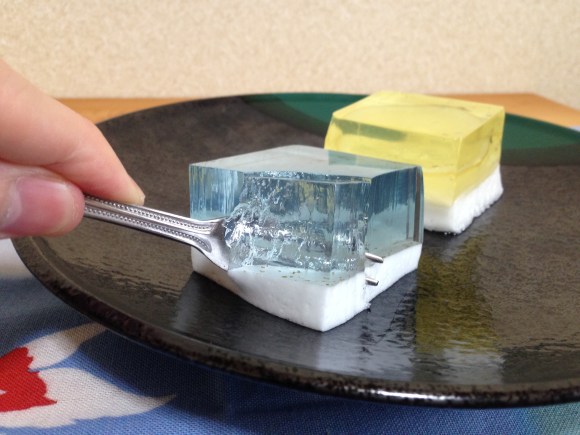
Gorgeous enough for the fanciest restaurant in Tokyo, this is actually available only from one of Japan’s most popular convenience store chains.
When it comes to food, Japan prizes both flavor and appearance, and that goes for desserts as much as anything else. But you don’t necessarily have to wait in line at a posh patisserie or decades-old confectioner to get your hands on some Japanese sweets that’ll make your mouth water with their deliciousness and your eyes water at their beauty.
The recently released sweets seen here, for example, might look fancy enough to be on the menu at an upscale Ginza cafe, but the truth is they’re both things you can pick up at any branch of the Natural Lawson convenience store chain for just 299 yen (US$2.70) each
They’re similar to yokan, a traditional Japanese dessert made with agar, sugar, and sweet red bean paste. Natural Lawson’s Ramune-kan and Lemon-kan don’t use bean paste, though, so while they have the firm gelatin texture of yokan, their flavor, and their appearance, is totally different.
Sold in the store’s cooler section, their plastic cases get a little foggy from condensation. Still, their dazzling blue and yellow colors are apparent even before you open the container, as are the flecks of gold that decorate the top of the Ramune-kan, which gets the first half of its name from Ramune, a popular type of vaguely citrus/apple-tasting soda in Japan.
The Lemon-kan, meanwhile, has a slice of lemon in its center section.
But though both look intriguing when looked at from above, they’re absolutely fascinating when viewed from the side.
Each has a meringue base, but their top sections are translucent, allowing light to shine through and bend in captivating ways. The Ramune-kan is especially entrancing, since it looks like a miniature glacier, or a tiny section of the sea, ocean floor and all, that’s formed itself into a dessert just for you.
Not that Lemon-kan is any slouch in the looks department either.
They also both have enticingly citrusy sweet scents.
But despite looking like liquid, they’re both fairly firm. Slice into one with the side of a fork, and you can cleanly cleave off a bite without the remainder of the dessert crumbling.
This also means that with each bite, you’re left with a new geometric shape to contemplate as you chew.
There’s no denying the Ramune-kan’s visual impact, but its taste is actually fairly understated, and less sweet than the drink that inspired it. Meringue isn’t a traditional yokan accompaniment, but it makes for a surprisingly pleasant combination here, and its airy texture also helps form a mental connection with Ramune soda, which is carbonated.
The Lemon-kan, on the other hand, packs the bigger flavor punch. When combined with its mereigue base, the overall effect is almost exactly like eating a lemon meringue pie, with just a little extra tartness.
However, not all beauty lasts forever. Slicing off a corner of the Lemon-kan is no problem, but you’ll soon have to make a cut through the lemon peel, which turns out to be a difficult task.
Since the peel is still on the slice, it’s hard to cut in half, and you’ll probably end up having to slide the whole thing out and eat by itself before going back to the gelatin and meringue. Because of that, you’ll want to take any pretty pictures you want of the Lemon-kan before you start eating it.
Still, this is far more beauty and deliciousness than we’d expect to find at a convenience store, even in Japan, and a fine, though inexpensive, dining experience that’s not to be missed.
Related: Natural Lawson location finder
Photos ©SoraNews24
Follow Casey on Twitter for more of his adventures in eating dessert in a professional capacity.